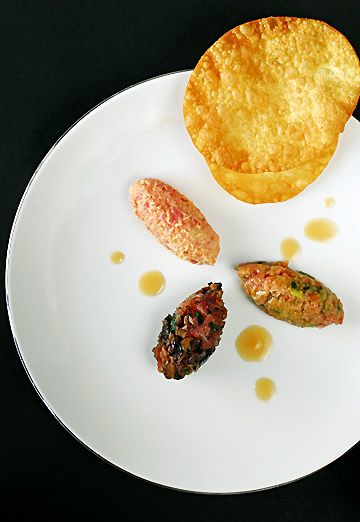
Don’t. Don’t cook it. Because tuna, I believe, should be eaten raw. Cooked tuna, for the most part, to me at least, isn’t appetizing. A grilled tuna steak, while popular in many places, turns me off. Cooking tuna usually turns this succulent, soft, and delicious fish into a hard, tough and tasteless thing. Searing tuna is a trendy attempt by chefs to reach a compromise between serving the fish raw, as it should be, and cooked, which is how far too many of their guests expect their fish to be served. I’m not one for seared tuna. For one, it’s far too chi-chi. And more importantly, unless you’re searing an incredibly fatty piece of toro, I don’t really think the process adds any additional or necessary flavor to the fish.
The best way to eat a great, fresh and fatty piece of tuna is raw, with some wasabi and soy sauce — sashimi-style. Another good way, albeit also very trendy these days, is to have it in a tartare. The method of preparing tartares dates back to the Mongols, who brought the dish to Russia during the 13th century (when they invaded). Later, the German port of Hamburg received ships that visited Russia. The sailors brought back with them what they began to call “tartare steak”. Even later, ships from Hamburg brought a cooked version to New York. This, as you can guess, is where hamburgers came from.
A tartare is essentially a mixture of a finely chopped raw meat and a number of other ingredients. Sort of like really yummy baby food.
Ever since my wife S and I got a copy of Nancy Oakes’ cookbook Boulevard, I’ve wanted to make her Trio of Tuna Tartares. They sounded and looked delicious. The first one is a jalapeno and ginger tartare (pictured at bottom left in the photo). The second is what Ms Oakes calls a spicy red chili tartare (top left). The third is a shiitake and white soy tartare (the one on the right). While relatively easy to make, I discovered a small problem with Ms Oakes’ recipes. Basically, the quantity of other ingredients she calls for is far too much for the amount of tuna she requires for each tartare. I found myself tweaking each recipe substantially, cutting back on some ingredients while substituting a few others.
The end results, fortunately, were very good. We used a combination of toro (fatty tuna) and normal tuna. S enjoyed the shiitake and white soy tartare best. I liked them all. If asked to choose a favorite, I’d probably say the jalapeno and ginger tartare. I liked the combination of jalapeno peppers, ginger, sweet chili sauce, lime and avocado. We served the tartares with deep-fried wonton skins. These tartares are excellent as starters or canapés. The leftovers are also fantastic served over a bowl of piping hot rice.
Trio of Tuna Tartares
Serves 8
Jalapeno and ginger tartare
170g sashimi-grade tuna, diced finely
3 small jalapeno peppers, seeded, deribbed and diced
1/2 tablespoon grated young ginger
4 tablespoons grape seed oil
2 tablespoons Thai sweet chili sauce
1.5 tablespoon light soy sauce
1 tablespoon rice vinegar
1 ripe avocado
juice of half a lime
Combine the tuna, jalapeno, ginger, oil, chili sauce, soy and vinegar in a bowl. Mash the avocado in another small bowl and add the lime juice. Stir this into the tuna mixture.
Spicy red chili tartare
170g sashimi-grade tuna, diced finely
2/3 cup Japanese mayonnaise
2 teaspoons Chinese garlic chili paste (we used a chicken rice chili sauce)
1 sac of mentaiko
1 teaspoon spicy cucumber oil (optional)
Cut the mentaiko sac open and scrape all the roe into a bowl. Combine all the other ingredients in the bowl and mix well.
Shiitake and soy tartare
170g sashimi grade tuna, diced finely
150g fresh shiitake mushroom, stems removed and diced
2 tablespoons light soy sauce
1 tablespoon grape seed oil
4 teaspoons sesame oil
4 tablespoons thinly sliced scallions
1 tablespoon mixed black and white sesame seeds, toasted
Put the grape seed oil in frying pan and heat. Mix the diced shiitake with the soy and sesame oil. Pour the shiitake, soy and sesame oil into the grape seed oil and cook for 5 minutes or until the mushrooms are soft and tender. Set aside and let cool. Stir this together with the tuna, scallions and sesame seeds.
I found that prepping the tartares ahead of time and letting them sit in the refrigerator for an hour or two before serving really helps the flavors come together.
About Aun Koh
Aun has always loved food and travel, passions passed down to him from his parents. This foundation, plus a background in media, pushed him to start Chubby Hubby in 2005. He loves that this site allows him to write about the things he adores--food, style, travel, his wife and his three kids!
